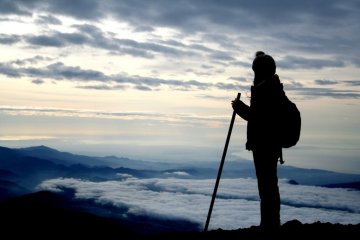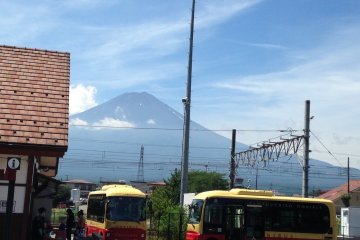My first attempt at seeing the majesty that is Mt. Fuji occurred on a day before a typhoon and there was nothing to see but clouds, clouds and more clouds. My second attempt was more successful and together with my friend we climbed to the top of Mt. Fuji and experienced the mountain in all its majesty.
When I recall the images of Mt. Fuji that I have seen over the years, I notice that the mountain is always pictured with a snow-capped peak. Perhaps this is because it looks more picturesque? Or maybe there is a hint that the mountain is somehow inaccessible to the ordinary person? After all, mountains are commonly believed to be the place for the kami. In times past, climbing Mt. Fuji was considered a pilgrimage. Pilgrims would wear white garments to show their purity of thought and heart. Not everyone was able to climb to the top in those days.
These days, when I read contemporary reports about climbing Mt. Fuji, I come across romantic and sporting reasons to climb as well as complaints over the mountain's coldness and the physical difficulties in climbing it. So why climb Mt. Fuji? Is it just to see the sunrise? I can see the sunrise everyday from my window. Perhaps people climb to overcome something difficult in their lives?
I don't know the answer. I rarely read anything about the mountain's spiritual motivation. For me, this is the most important thing, the spiritual nature of the climb. If the mountain is considered to be close to the gods, then those who reach its peak must see something extraordinary from there....
The idea of climbing Mt. Fuji always comes to me suddenly and I can't let it go. Setting myself to it, I really wonder what thoughts I will entertain while climbing and what changes - if any - will occur after.






